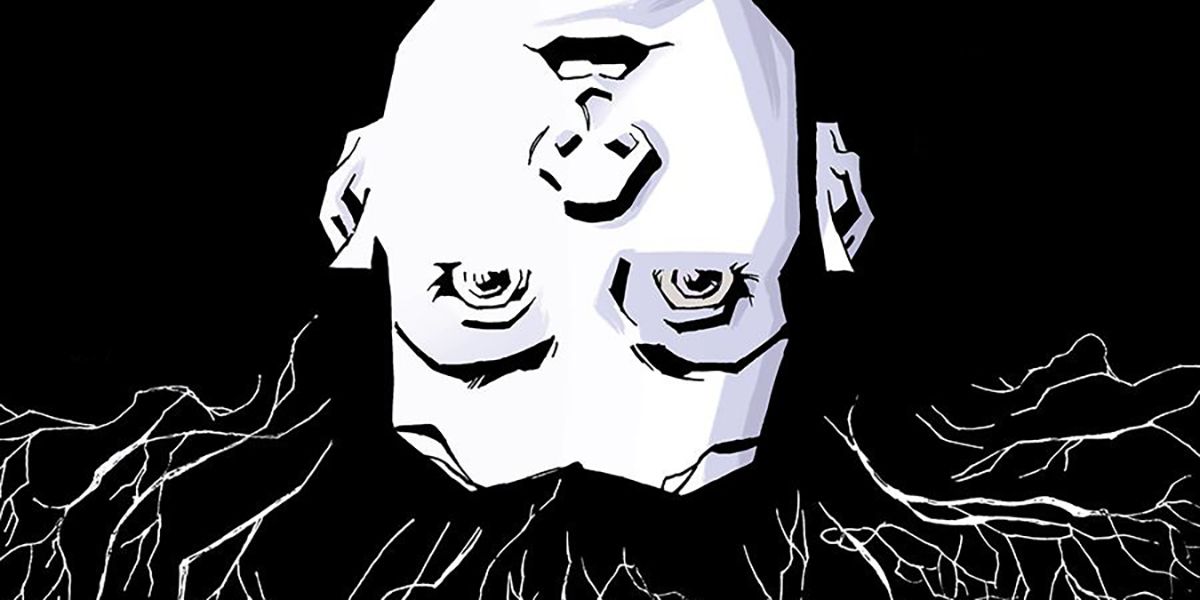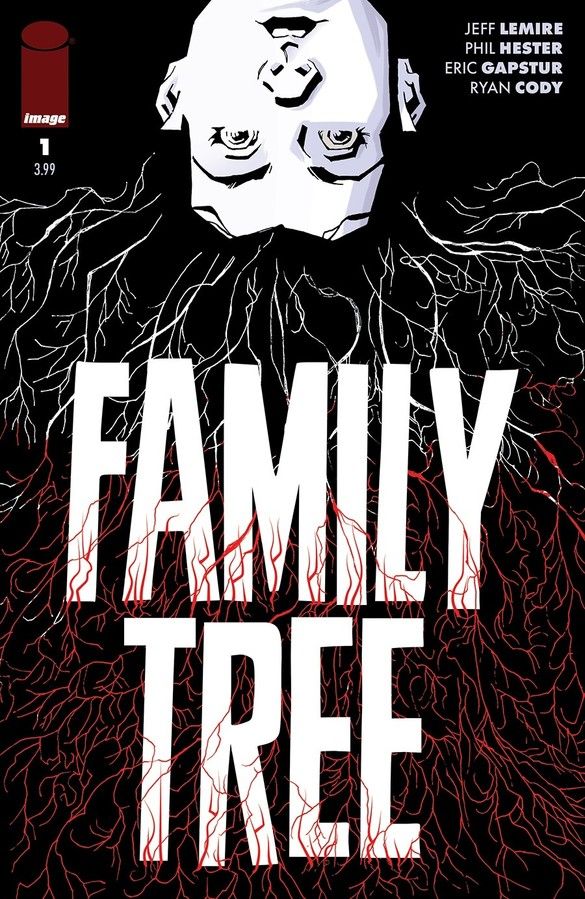Writer Jeff Lemire (Animal Man, Black Hammer) and artist Phil Hester (Green Arrow, Shipwreck) are two comics powerhouses. Lemire and Hester have worked for such publishers as Marvel, DC Comics, Dark Horse Comics and more, receiving a lot of praise for their work in the process. The two are now teaming up for a new ongoing horror series from Image Comics: Family Tree.
The story of that upcoming book follows Loretta Hayes and her two children, Joshua and Meg, as the lattermost of the three starts to transform into a tree. On their quest to save Meg's life, they'll be joined by the family's eccentric -- possibly insane -- grandfather on a quest to Meg's life. Family Tree explores a lot of different themes -- such as family, fear and more -- in its first issue, while also embracing body horror in its depiction of Meg slowly losing her human form, drawing comparisons to the work of David Cronenberg and Junji Ito's Uzumaki in the process.
CBR talked with Lemire and Hester over about Family Tree. In the interview, the creative team talked about some of the story choices, influences on the book, writing "pre-apocalyptic" fiction and much more.
CBR: In the early pages of Family Tree, you choose to reveal that this is really just the opening salvo of this particular apocalypse. Why did you guys make the choice to reveal that this was only the beginning?
JEFF LEMIRE: I thought it was a great way to tease the larger stakes of the story and give it an epic, almost mythic feel as a backdrop to what is a very specific story about one family. To show that, while the story will focus on this one family, it has greater implications to the world at large. Also, the apocalypse teased in the opening may or may not come to pass, that will be part of the mystery moving forward.
You’ve chosen to set the beginning of the end of the world on a very particular date: March 14, 1997. Why that date?
JL: The onset of technology, specifically cell phones, would make certain details and aspects of the story that I want to tell very difficult. I know that’s not a very specific answer, but I don’t want to spoil what’s coming. In general I find that cell phones and the internet don’t fit well into a lot of my stories. I’m not sure why that is, maybe I like how much more disconnected characters can feel without them.
Family Tree is billed as an ongoing series. Do you guys have any definitive end in mind or length you see the series running?
JL: I do have an ending in mind, but the journey to get there may stretch or change as we go. As with all things we need to see how people respond to the book, and if the audience is there, we would love to tell a big sprawling story for sure. But I always need to know my end point, and Family Tree is no different. It is going in a very specific direction and the greater mythology and mystery has been all worked out in advance.
Phil, on Twitter the other day you said there would be no variants for Family Tree and "everyone gets the same damn comic." Can I get you guys to talk a bit more about your opinions on variant covers?
JL: I don’t mind them, personally. I love seeing other artists interpret our characters. But for Family Tree we really wanted to focus on Phil and his vision for this book and make it a very singular thing.
PHIL HESTER: Well, I was just having a little fun. I certainly don't have any negative feelings about variant covers. We used them on my last Image book, Mythic. They were a lot of fun and goosed sales a bit. They can be a useful tool. That said, I know a lot of retailers are weary of chasing order thresholds to get rare variants. I was expressing a little solidarity with their fatigue.
What books and media did you look to for inspiration and reference when you were creating Family Tree? Junji Ito's Uzumaki and the works of Cronenberg have been mentioned in relation to the book.
JL: Funnily enough I have never read any Uzumaki, and I have only really watched Cronenberg’s later period films where he had stopped doing so much horror. But I can certainly see why these would be referenced here. Honestly, Alan Moore’s Swamp Thing was the biggest inspiration as was my own time writing Animal Man. I really loved writing the mix of horror and family dynamic in that story and missed it, so are started building my own story where I could explore that a bit more.
PH: I certainly like those creators, but wouldn't consider them a direct influence on what I'm trying to do with Family Tree. Throughout my career I've straddled the two worlds of indie books and superhero comics, favoring the dark and angular side of my style for those edgier projects and the cleaner, streamlined look for mainstream gigs. FT definitely falls into that darker side of things, so I naturally lean toward my grittier drawing influences like Jose Muñoz, Jorge Zaffino, Alberto Breccia, even Jeff Lemire! The storytelling decisions themselves are still 100% Hester, for better or worse.
Jeff, this isn't the first time you've worked with apocalyptic settings. You've done, for example, Sweet Tooth. What appeals to you about telling stories of humanity's struggles with its last days?
JL: I don’t really see this one as an “apocalyptic” book. While we tease a certain type of world ending in the first issue, it may not turn out the way it first seems. There is a bigger mystery here and these visions of the end of the world are part of that.
Having said that, I always loved post-apocalyptic stuff. I love the heightened stakes of these worlds and the extremes people can go to, so it is a fun setting for sure. If anything Family Tree is more a reflection of the uncertainty of the world we currently live in, and the fears I have as a parent trying to keep that away from my own family. So I think this is a “Pre-Apocalyptic” story not a post.
Phil, you do a lot of work on horror comics. In what ways is Family Tree different from other books you've done?
PH: I threw out my straight edge. All the themes of the book revolve around life, death, decay, rebirth, nature run amok, human frailty. Those all seemed to call for a more spontaneous line, something itchy. I want the drawings to have a life of their own, a life that seems to be growing out of control like cancer or weeds. Rendering everything with spidery lines and miasmic blacks puts me in the mind of an open grave, for good or ill. I mean, it's this yawning pit of blackness and oblivion, but it's still the earth itself, the source of new life.
I always strive for some economy in my drawing, but if I pared this book down to Toth-like cleanliness it would become sterile and cold. To get technical, I tried to make sure I was always holding my pencil near the end, far from the point. I wanted to cede a little control and bring in some-- if not outright automatic mark-making-- idiosyncratic, less controlled drawing decisions.
I wanted lines to almost take their own course in this book, to indicate that life itself takes its own unpredictable turns. Like nature itself, I wanted the pretty things to have some ugliness just under the surface, and the ugly things to have a kind of intractable, divine grace. That all sounds kind of insufferable, but I've been doing this over 30 years, and am always searching for some new methods to keep things fresh and engaging for me as an artist. I hope the reader sees those aesthetic decisions the same way.
Eric Gapstur and Ryan Cody are also working on this book with you guys. What about them makes them ideal for this project?
PH: I've been working with both guys for quite a while now, especially Eric. When Ande Parks, my usual long-time inker, stepped away from everyday inking to focus on writing, I needed a new partner. Thankfully, I'd known Eric since he was a student and knew he had the chops to step into Ande's place. I think Eric brings more affinity for the dead line (meaning a line without illustrative line weight variations or florid brushstrokes) than most other inkers would. This book is meant to look creaky and brittle. Eric's deft enough to put aside his own rather warm and expressive drawing style to give me back the spindly pen lines and bottomless black spaces required by the title.
Ryan, also an ace illustrator in his own right, approaches these pages with the full knowledge of exactly what they need to function as a whole, not merely to replicate natural light or color. He lets the drawing do the talking. I couldn't be happier with his muted palettes and judicious restraint in modeling. This book has a lot of nightmarish qualities, and Ryan knows how to evoke that sensibility with diffused light and non-literal color choices. Pretty amazing.
What's the most challenging part of working this book for both of you?
JL: Working with Phil. He is a total diva.
But seriously…just balancing the mystery and giving the book a great momentum without revealing too much too soon. But these are fun challenges.
PH: Trying to stay out of old habits. Like I said, I've been doing this for 30 years. I have tried and true methods for almost every situation. But for this book, I want everything to be spontaneous and fresh. That means, counterintuitively, contemplating each page for a lot longer than normal before beginning the drawing. Of course, I dash through the thumbnails pretty quickly, as usual. But in the case of FT, I back off before drawing and let the pages stew for a bit. Invariable, I will find another angle or layout that's more rewarding than my initial, "good enough" solution. We'll see if this two-stage process survives once deadlines get tighter.
Also, Jeff's scripts are a challenge in themselves. Not that they're difficult to translate to images, but that they convey a subtlety, especially in dialogue, that I am always struggling to match with my character's acting. There's true poetry in Jeff's story, it's my job to turn it into a song. I'm not that confident in my voice, but I'll be out there sweating blood on the stage, giving it everything I've got.
Family Tree #1 releases November 13 from Image Comics.


